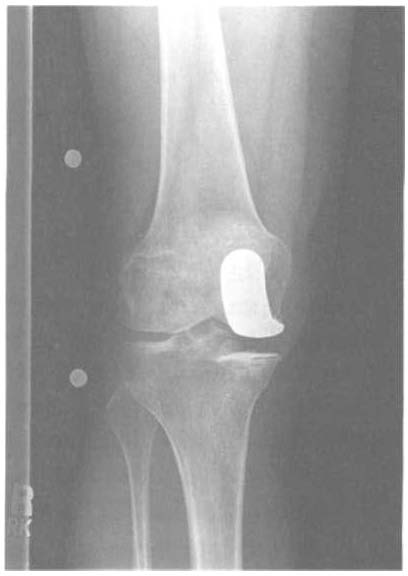i bc27f85be50b71b1 (61 page)
Read i bc27f85be50b71b1 Online
Authors: Unknown
194
ACUTE CARE HANDBOOK FOR PIIYSICAI THERAPISTS
incision made in the muscle mass and joint capsule for exposure of
the hip during surgery. Consequently, the hip remains at risk for dislocation until these structures are well healed, edema is reduced, and the surrounding musculature is strengthened. Signs of dislocation
include excessive pain with motion, abnormal internal or external
rotation of the hip with limited active and passive motion, and shortening of the Iimb.40
Medical complications that may occur after THA include nerve
injury, vascular damage and thromboembolism that can cause pulmonary embolism, myocardial infarction, and cerebral vascular accident.
Complications pertaining to the implant can include fracture, asepric
loosening, osteolysis, heterotopic ossification, and infection.43
Physical Therapy Intervention after Hip Arthroplasty
Early physical therapy intervention is focused on functional mobility,
patient education about movement precautions during activities of
daily living (ADLs), ROM, and strengthening of hip musculature.
Physical therapy may assist in preventing complications, such as
atelectasis, blockage of the intestines because of decreased peristalsis
secondary to anesthesia (postoperative ileus), and D VT. Early mobilization improves respiration, digestion, and venous return from the lower extremities. Patients should be educated about these risks to
assist in prevention of secondary complications.
• The priority of treatment is to achieve safe functional mobility
(i.e., bed mobility, transfers, and ambulation with assistive devices)
to maximize independence and functional outcome. Patient education is an important aspect of physical therapy. The physical therapist should educate the patient about movement precautions while encouraging use of the operated limb with functional activities.
Verbal and tactile clieing may assist a patient in precaution maintenance; failure to do so may result in hip dislocation. The therapist should educate the patient that movement of the operated hip can
decrease postoperative pain and stiffness.
•
ROM (passive and active assisted) should be maintained within
the parameters of the hip movemenr precautions. An overhead
frame with a sling can promote active-assisted exercise.
• Isometric exercises for the quadriceps and gluteal muscles can
be initiated immediately postoperatively, progressing to activeassisted exercises as tolerated. Muscle spasm oftcn occurs in the

MUSCULOSKELETAL SYSTB1
195
musculature surrounding the hip postoperatively. Instructing the
patient in exercises to gain control of the musculature involved in
the surgery can help to reduce muscle spasms. Patients should be
encoutaged to perform all exercises independently.
o To assist in the prevention of DVT and reduce postoperative
edema, the patient should be instructed to perform ankle-pumping
exercises. This can be combined with external compression devices
and antiembolic stockings to reduce the risk of a thromboembolic
event. Before use of these modalities, ensure that the patient does
not have cardiovascular insufficiency that may be exacerbated by
their use.
o Before establishing an advanced strengthening program consisting of progressive resistive exercises or weight training, consult the surgeon, because excessive strain can hinder healing of surgically
involved structures.
Clinical Tip
• All peripheral innervations, dermatomal and myotomal, should be assessed on initial examination, with
emphasis on the femoral nerve that innervates the quadriceps and the sciatic nerve that innervates the peroneals.43
Neuropraxia of the femoral nerve can occur secondary to
compression from surgical instrumentation and edema. A
knee immobilizer may be necessary to provide stability if
the quadriceps lacks adequate strength and stabiliry for
ambulation. If the peroneals are affected, resulting in a
footdrop on the affected side, a custom-fit ankle-foot
orthosis may be indicated for the patient to optimize gait.
o The use of a knee immobilizer reduces hip flexion by
maintaining knee extension. This can be helpful in preventing dislocation in patients who are unable to maintain
posterior hip precautions independently.
o Instruct the patient to avoid pivoting on the operated
extremity when ambulating. Instead, the patient should
turn by taking small steps and flexing the knee of the operated leg to clear the toes. To maintain movement precautions, the patient is encouraged to turn away from the operated limb.

196
AClITE CARE HANDBOOK FOR PHYSICAL THERAPISTS
•
Emphasize to the patient that combining any of the
restricted movements will increase the likelihood of dislocation. Provide the patient and family with written
and illustrated education materials on all movement
precautions.
•
Elevation of the height of the bed can facilitate sit-tOstand transfers by reducing the degree of hip flexion and the work of the hip abductors and extensors. This is especially helpful for patients with bilateral THA. Also,
instruct the patient to place the operated leg forward when
performing a stand-to-sit transfer to decrease hip nexion.
• If available, a hip chair (or other elevated seating surface) and commode chair should be used to facilitate transfers while maintaining hip precautions. Pre- and postoperative education in the u se of furniture of the appropriate height in the home should be initiated by the physical rherapist.
Klfee Arthroplasty
Knee arrhroplasry is indicated for patients with end-stage osteoarrhritis, rheumatoid arthritis, traumatic arthritis, or nonseptic arthropathy. Pain reduction, gaining intrinsic joint stability, and restoration of function are the primary goals associated wirh knee arrhroplasry and
should only be considered when conservative measures have failed.
The extent of damage within the joint determines the rype of prosrhesis implanced: unicompartmemal or tricompartmental.
A Imicompartmelftal (Ullicondylar) or partial knee arthroplasty is
the replacement of the worn femoral and tibial articulating surfaces in
either the medial or lateral compartment of the joint ( Figure 3-15).
This surgery is indicared for individuals who have osteoarthritis or
osteonecrosis confined to one compartment. Proponencs of the unicompartmental knee arthroplasty believe that it is a conservative measure to promote a more functional knee.44 In unicompartmemal knee arthroplasry, the goal is to maximize the preservation of the articular
cartilage of the healthier compartment and spare bone that may in
turn delay a tOtal knee arthroplasty. More of the joint is preserved,
including the cruciate ligaments, rhe opposire ribiofemoral compartment, and the patellofemoral joinr. The rehabilitation is quicker, and




